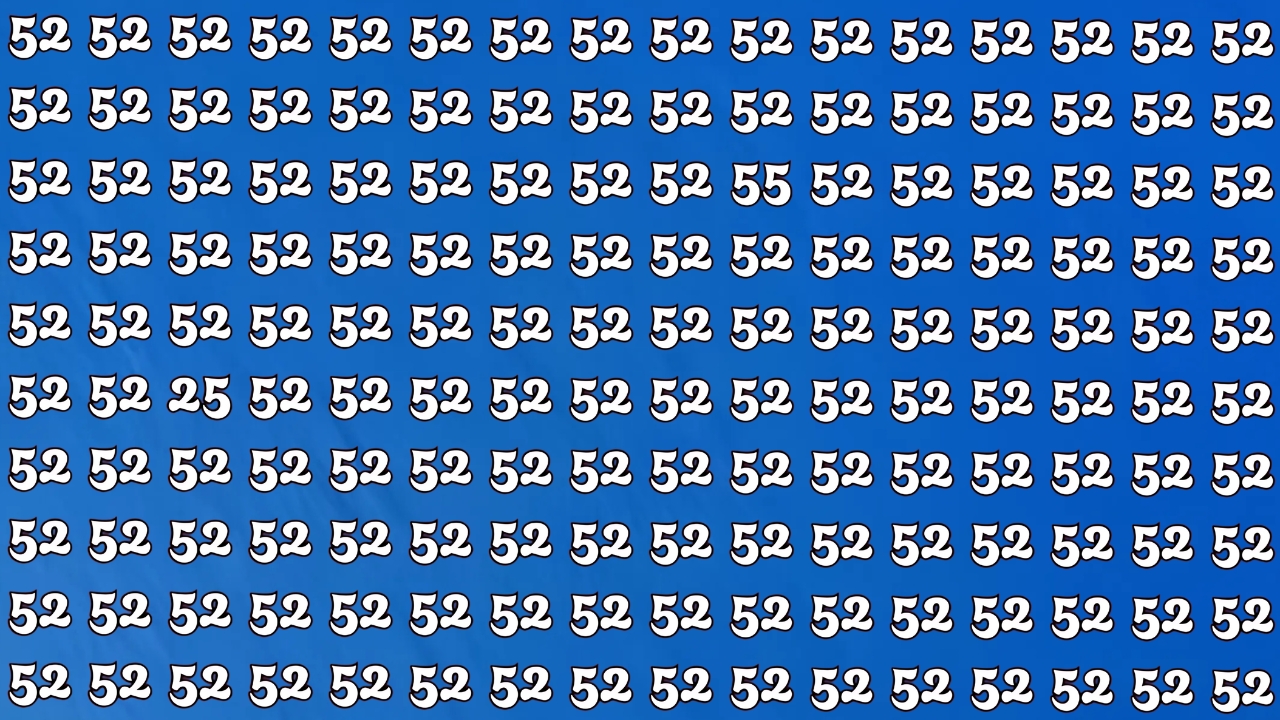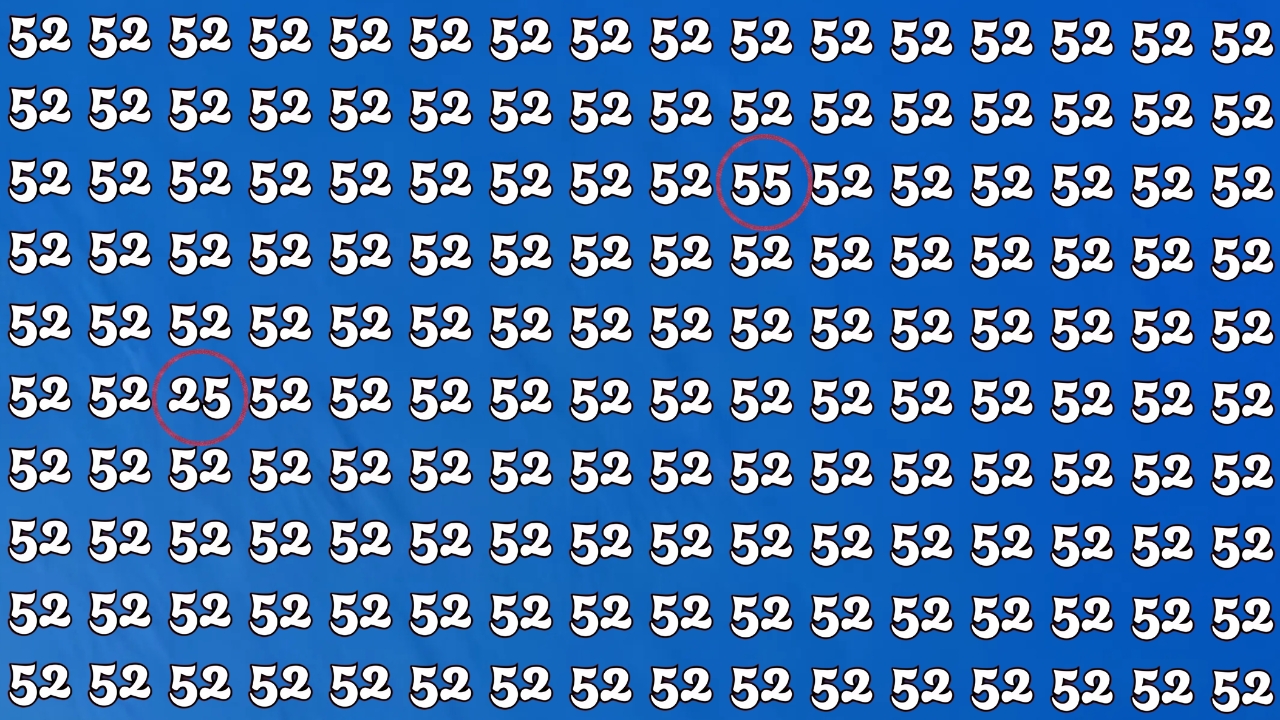Find The Hidden Numbers 55 and 25 : you’re staring at what looks like a simple grid of numbers, all appearing to be “52” repeated over and over on a bright red background. But here’s the twist – hidden somewhere in this visual maze are the numbers “55” and “25,” and you’ve got just seven seconds to find them both. Sounds easy? Think again!
This particular brain teaser has been stumping people worldwide, and it’s a perfect example of how our minds can play tricks on us. When we first glance at the image, our brain quickly recognizes the pattern of repeating “52s” and essentially goes into autopilot mode. It’s like when you’re looking for your keys and they’re sitting right in front of you – sometimes we see what we expect to see rather than what’s actually there.
Why Your Brain Gets Fooled

Our visual system is incredibly sophisticated, but it has some interesting quirks. When we look at repetitive patterns, our brain tries to be efficient by grouping similar elements together. It’s basically saying, “Oh, I see what’s happening here – it’s just a bunch of 52s, so I’ll process them all as the same thing.” This mental shortcut usually serves us well in daily life, but it can work against us in challenges like this one.
The creators of this optical illusion understand exactly how our perception works. They’ve deliberately chosen numbers that share similar digit shapes – the “5” in “55,” “25,” and “52” all look quite similar at first glance. When these numbers are presented in rapid succession across a colored background, it creates what experts call “visual masking.” Your brain gets so focused on the dominant pattern that the different numbers blend into the background noise.
Think of it like trying to hear a specific conversation in a crowded restaurant. All the voices blend together into a general hum, making it difficult to pick out individual words unless you really concentrate. The same principle applies to visual information – when everything looks similar, the differences get lost in the visual “noise.”
The Art of Actually Finding Those Hidden Numbers
So how do you beat this challenge? The key isn’t to scan frantically across the entire image in those seven seconds. Instead, you need to change how you’re looking. Try these approaches:
Start by taking a deep breath and relaxing your eyes slightly. Don’t focus too hard on any one spot initially. Let your vision go a bit “soft” – this technique helps some people notice patterns and differences more easily. It’s similar to how you might look at those magic eye pictures that were popular in the 1990s.
Next, try dividing the image into sections in your mind. Look at the top third, then the middle, then the bottom. This systematic approach prevents your eyes from jumping around randomly and missing important areas. When you’re searching systematically, you’re more likely to catch those subtle differences.
Another effective strategy is to look for numbers that seem slightly “off” or different, even if you can’t immediately identify what makes them different. Sometimes your peripheral vision picks up on these differences before your direct focus does. Trust those instincts – if something catches your eye, even briefly, take a closer look.
Why These Challenges Are Actually Good for You
Beyond just being fun, these optical illusion challenges serve as excellent exercise for your brain. They help improve what researchers call “visual attention” – your ability to focus on relevant information while filtering out distractions. This skill is incredibly valuable in real-world situations.
Consider how often you need to spot important details in busy environments. Whether you’re looking for a specific item in a cluttered store, trying to find your car in a packed parking lot, or scanning a document for key information, you’re using the same visual processing skills that these challenges train.
Regular practice with visual puzzles can also help maintain cognitive sharpness as we age. Studies have shown that people who regularly engage in activities that challenge their visual processing tend to maintain better attention and focus abilities over time. It’s like going to the gym, but for your visual system.
The Psychology Behind Our Puzzle Obsession
There’s something deeply satisfying about solving these challenges, isn’t there? When you finally spot those hidden numbers, you get a little rush of accomplishment. This isn’t just in your imagination – your brain actually releases a small amount of dopamine when you solve puzzles successfully. It’s the same neurotransmitter involved in other rewarding activities.
This reward system explains why these challenges spread so quickly on social media. People love sharing their success and challenging their friends to beat their time. It creates a positive cycle where the challenge becomes both a personal achievement and a social experience.
The time pressure adds an extra layer of excitement. Seven seconds feels simultaneously like plenty of time and no time at all. This creates what psychologists call “optimal challenge” – difficult enough to be engaging, but not so hard that it feels impossible.
Making the Most of Your Challenge Attempt
When you’re ready to take on this specific challenge, set yourself up for success. Make sure you’re looking at the image on a decent-sized screen if possible – squinting at a tiny phone screen makes the task unnecessarily difficult. Good lighting helps too; you want to minimize any glare or shadows that might interfere with your vision.
Don’t put too much pressure on yourself to succeed in exactly seven seconds. If you need more time to find both numbers, that’s perfectly fine. The goal is to exercise your visual processing skills and have fun, not to stress yourself out. Some people find the numbers immediately, while others need a bit more time to train their eyes to see past the dominant pattern.
Remember that the numbers “25” and “55” are definitely there – they’re not impossibly tiny or hidden in some sneaky way. They’re the same size as all the other numbers; they’re just camouflaged by the repetitive pattern of “52s” around them.
Optical Illusion Answer

These optical illusion challenges remind us of something important about human perception: we don’t see the world exactly as it is. Our brains are constantly interpreting, filtering, and making assumptions about the visual information we receive. Usually, this works beautifully, allowing us to navigate complex environments efficiently. But occasionally, these same processes can lead us astray.
Understanding how our vision works – both its strengths and limitations – can make us better observers in all areas of life. Whether you’re trying to spot the hidden numbers in this challenge or simply paying closer attention to the details around you, the skills you develop through these exercises have real-world applications.
ALSO READ: Optical Illusion : Find Hidden leopard cub’s face